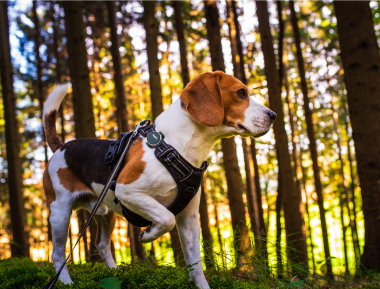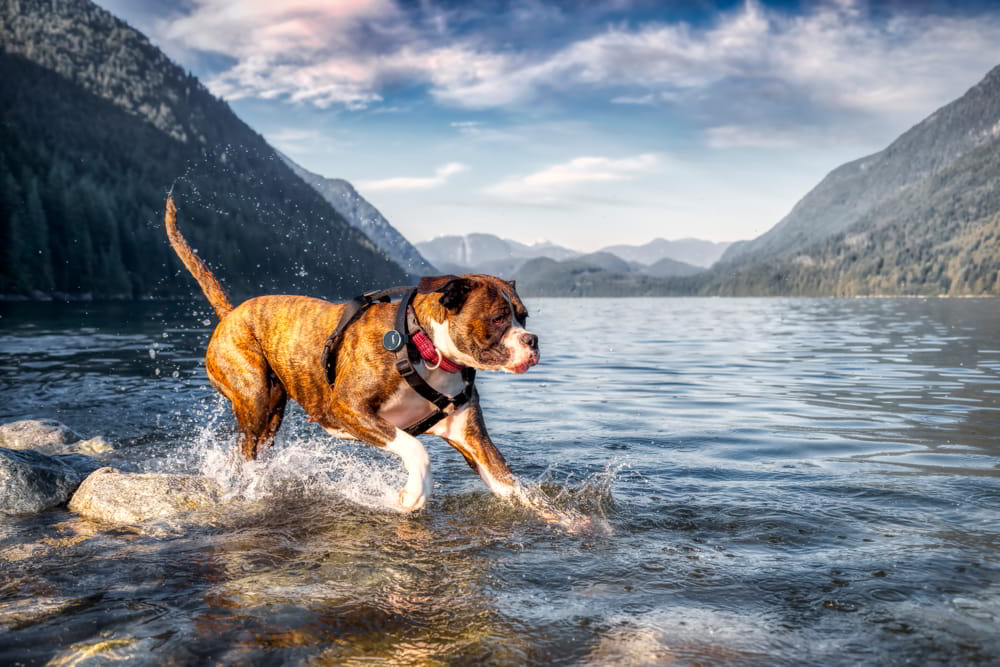TrackiPet shares the best dog training tips and tricks for harmony in the home and beyond.
Whether you’ve just brought home an adorable puppy, you’re fully bonded with your longtime hound, or you’re embarking on the rewarding adventures of adult-dog adoption, proper dog training is essential. Dog training is important because it:
- Facilitates cohabitation
- Helps you bond and communicate
- Improves socialization
- Provides mental stimulation
So, you know that training will help you cultivate a beautiful relationship with your furry friend. But where to begin? We’ve made you this comprehensive guide to demystify dog training. Here’s what you’re going to learn today:
- Part 1 - Knowing your dog and yourself
- Part 2 - Basic Obedience Training
- Part 3 - Socialization
- Part 4 - Behavior Training
- Part 5 - Advanced Mental Stimulation
Sound like a lot? Don’t worry! The most important thing is to have fun while you build a deep, lasting bond with your pooch.
Part 1 - Knowing your dog and yourself
As with any great relationship, a little soul searching can go a long way in moderating your expectations and helping you craft your communication style.
Know your dog - Nature vs Nurture
Nature: What do you know about your pooch’s breed? Are they a worker? Super energetic or pretty chill? Understanding your dog’s genetic instincts can help you love their quirks and provide a fulfilling lifestyle.
Nurture: Did your new puppy start its life indoors or outdoors? Socialize much? If you’re adopting an adult dog, it has likely formed habits and behaviors based on its former lifestyle. All this life experience can have a huge influence on training.
TIP: Information about your dog will help you strategize, but it isn’t everything. Observation, love, and patience are the true keys to training success.
Know yourself
Let’s get real; how much time and space do you really have to dedicate to training? Make sure you set realistic expectations for your dog training regimen. A few 5-minute training sessions each day will get you really far.
TIP: Use training to build community. Exchange knowledge with other dog parents and qualified trainers.
Finally, let’s talk technique. There are a million dog training methods out their and—despite what some might say—they’re pretty similar! All training methods rely on…
Operant Conditioning - using rewards and/or aversive consequences to encourage or discourage certain behaviors.
Here are some of the most popular dog training methods in 2023:
- Positive Reinforcement - Immediately identify and reward desired behaviors with treats, toys, praise, and playtime.
- Balanced Training - a balanced system of rewards and (gentle!) aversive consequences.
- Scientific Training - Enhance your training regime by incorporating the latest studies about dog behavior, breed, environmental conditions, etc.
- Relationship Training - a slow, rich process of observing all of the factors that motivate your dog’s behavior and addressing them from their root causes.
TIP: It’s ok to mix and match!
Part 2 - Obedience Training
Basic obedience training establishes consistent communication between you and your dog, as well as the essential commands for safety and cohabitation.
TIP: Keep training sessions short (5 minutes, a few times a day), consistent, gradual, and—most importantly—fun!

Chart Credit:www.facebook.com/PAWSabilityCenter
Reliable Recall
Teaching your dog to “come” when called is a crucial safety skill. Avoid rampant squirrel chasing and running in traffic by training your dog to “come” early and often.
Start at home. Create a small distance between you and your pooch. Then entice them to come to you with a treat. Once your dog comes to you reliably, incorporate the verbal command, “come.”
Gradually add greater distance, then unfamiliar or distracting environments, into your training sessions. Make sure pup masters each new addition before leveling up!
TIP: It’s tempting to use your dog’s name for recall, but that can get confusing. Using the command “come” gives you a better shot at true reliability.
Leash Manners
What’s more relatable than a dog who’s tuggy on the leash? Make your walks way more pleasant with a few simple hacks.
First of all, choose a collar or harness that fits your dog properly. It should be snug, but not tight. Make pooch sit calmly while you put on their collar and leash.
If your dog is pulling, give the leash a light tug, say no, and stop (or just stop). When the leash slackens, you can start walking again. Repeat as needed and reward proper walking with treats and praise.
House Training
Dogs are tidy, hygienic creatures, much like yourself. They want to keep their living space clean, so give new dogs plenty of opportunities to do the right thing.
The best way to train a new dog—puppy or adult—to potty outside is to take them out often and regularly and to learn the signs that they have to go. When you want your dog to potty, take them to the appropriate spot, on leash, and wait quietly until they do. Reward them with a treat or play.
TIP: A puppy can reasonably be expected to hold it for the same number of hours as their age in months (until about 9 months).
Accidents are inevitable! Clean them up thoroughly to avoid repeat offending. Crates and pee-pee pads can be great support tools, especially if your dog needs to stay inside for long periods of time.
Sit, Stay, and Leave It
“Sit,” “Stay, and “Leave It” are simple commands that will make your life easier and form the basis of a more advanced training regime.
Sit: Start by holding a treat in your hand, close to your dog’s nose. Then raise your hand up. Their eyes will follow your hand, making them naturally sit down. Praise them and give them the treat. Repeat until they begin to stay seated a bit longer. Then you can introduce the verbal cue.
Stay: Ask your dog to sit or lie down. Then give them a hand signal, like a stop sign. Wait a few seconds, say “stay,” and then give them the treat. Keep practicing, gradually asking them to “stay” for longer time intervals and at a greater distance from you.
Leave it: First, offer your dog a treat. Then, hold a second treat in your closed fist. Your dog will try to nudge it out of your hand—don’t let them! Be patient. Eventually, your dog should start to back off. The instant they do, open your hand and praise them generously. Keep practicing. When they regularly, consistently back away from the treat, you can add the verbal command “leave it,” then start to introduce other objects. Practice with a toy now and reap the benefits later, when Fido’s got hold of a smelly critter or your favorite slippers.
Part 3 - Socialization
Helping your furry friend feel comfortable around other dogs and people will make your life together safer, easier, and more fun. The steps to socialize adult dogs and puppies are much the same, but adult dogs might require more patience.
Start at home with plenty of treats on hand. Invite trusted canines and adults one by one for short periods of exposure, always rewarding calm behavior. Gradually add kids, puppies, and less predictable environments. Always ask permission before allowing pup to approach strangers.
TIP: If your dog struggles, don’t give up, just slow down.
Part 4 - Behavior Training
Behavior Training is a way to address undesired responses to certain situations, like separation anxiety, aggression, and excessive barking. Successful behavior training is deeply attuned to the root causes of the behavior and uses counterconditioning. According to the ASPCA,
“Counterconditioning is a treatment process that changes an animal’s fearful, anxious or aggressive reaction to a pleasant, relaxed one instead. It’s done by associating the sight or presence of a feared or disliked person, animal, place, object or situation with something really good, something the dog loves.”
TIP: Know when you need help. Mild and severe cases of undesired behavior can both be treated at home. However, especially with more severe cases, the help of a qualified expert can greatly improve your chances of success.
Part 5 - Advanced Mental Stimulation
Mental stimulation can be just as important as physical exercise for your dog’s wellbeing. Studies show that:
“Integrating appropriate challenge into the lives of captive animals can have a positive effect on behavioral and physiological indicators of stress, resulting in improved standards of welfare.”
You can give your dog the mental stimulation they need by training advanced skills like trick sequences, scent tracking, and puzzle toys.
Train advanced skills just like you train basic skills—build gradually, reward desired behaviors, and reinforce learning.
Go forth and train!
So, to recap:
- Patience and consistency are your most important dog training tools.
- Despite what many would have you believe, there is no one right way.
- Training should be fun for both you and pooch! It should also strengthen your relationship, communication skills, and confidence.
We hope that you now feel empowered and excited to begin your dog training journey.


